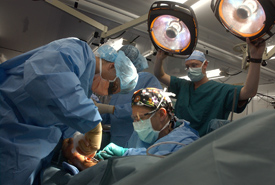Data quality

We have attempted to indicate the quality of data entry for cystectomy by comparing the returns with Hospital Episode Statistics (HES data) - this is information collected by every NHS hospital after a patient’s discharge from a surgical procedure. Unfortunately, HES data are not 100% reliable but ideally, all procedures recorded on HES will be entered by the surgeon on to the BAUS database for analysis. A coding percentage close to 100% suggests good recording; a percentage higher than this may indicate incorrect HES coding of procedures at the individual surgeon's hospital and a low percentage suggests incomplete recording by the surgeon or, again, poor HES coding.
Number of Operations
The number of operations indicates the number of radical cystectomy procedures undertaken by each surgeon. There is good evidence that better outcomes are obtained by surgeons who perform more procedures (high-volume surgeons), but this does not mean that low-volume surgeons have poor outcomes. These data include open, endoscopic, laparoscopic and robotic-assisted procedures for cancer of the bladder.
The data are taken from the BAUS Data and Audit System for procedures performed between 1 January 2014 and 31 December 2016.
The number of operations reported may be lower if a surgeon has only worked through part of the relevant time period.
This is the second year of publication for these data and we are currently working to identify the parameters necessary to risk stratify the data.
Certain surgical techniques do appear to be associated with differing outcomes. For example the transfusion rates for open cystectomy appear to be higher in general when compared to a robotic assisted approach. This doesn't however mean that a person undergoing an open operation will have a poorer outcome.
Transfusion rate
This is the proportion of patients (expressed as a percentage) requiring a blood transfusion following surgery. It is often related to the complexity of the procedure and, separately to the underlying health of the patient. It may also be an indicator of complications that have arisen following the procedure.
The transfusion rate reported does not take into account the patient’s pre-operative haemoglobin level. If a patient is anaemic before the procedure, this may make him/her more likely to need a transfusion post-operatively.
The reported tranfusion rate only identifies whether a patient received a blood transfusion during their admission for radical cystectomy; it does not identify whether the patient was re-admitted later for transfusion. Patients requiring only a single unit of blood are recorded in the same way as those requiring multiple units of blood (i.e. they either did or did not receive a blood transfusion, with the number of units transfused not being recorded).
The transfusion rate reported may be lower if a surgeon operates only on less complex cases or on patients who are less sick; equally, it may be higher if the surgeon operates on more complex cases or patients.
The red vertical lines displayed on the graphs indicate an acceptable amount of variation (99% and 99.9% alerts). If the figures from your surgeon or unit are shown as lying within these inner boundaries (i.e. the dark blue bar is to the left of the red lines), then that surgeon/unit is graded as "acceptable".
We would look closely at surgeons/units if their figures lie beyond the 99% alert. If the blue bar is to the right of the 99.9% line, the surgeon is termed an “outlier”, and further investigation is essential to determine whether there may be a cause for concern.
Length of Stay
The length of stay following the operation can be influenced by the technique employed to carry out the procedure, an individual patient’s general health or complications of surgery, logistical issues (such as the distance they live from where the surgery is carried out) and individual surgeons' practice.
Average Patient Risk Profile
Some units/surgeons will be operating on patients with co-morbidities which put them at higher risk of complications, increased length of stay, transfusion, and ultimately post operative mortality. We are currently working to identify the parameters necessary to risk stratify the data. It is hoped that by presenting the data in this context, this will more accurately reflect an individual surgeons/units outcomes. Thus far we have identified, age >75, BMI, pre op anaemia, cardiopulmonary exercise tolerance & renal impairment as factors which increase risk.
N.B. BAUS has included all the data returned in our overall analysis but, when presenting individual surgeon’s results, we have excluded those surgeons who returned less than five cases for the year because any statistical analysis of such a low number would be invalid.